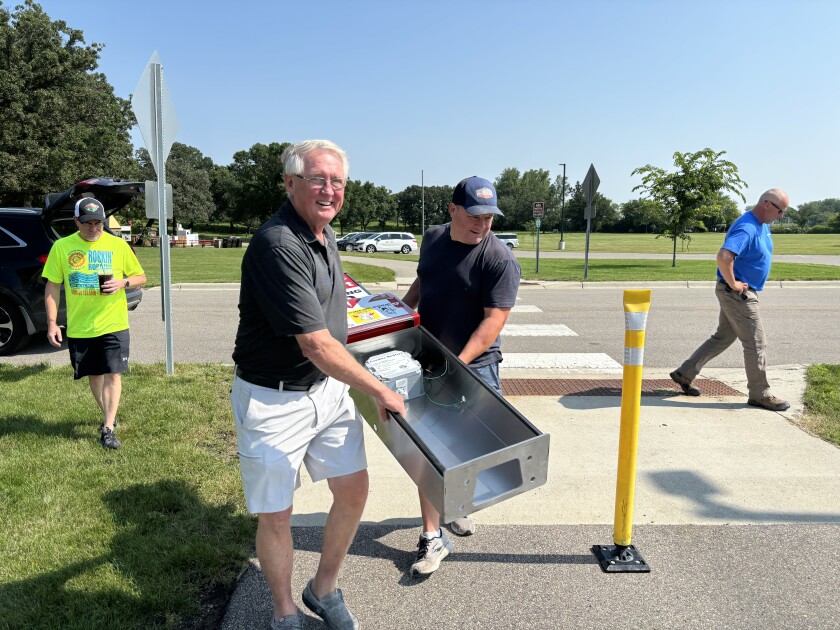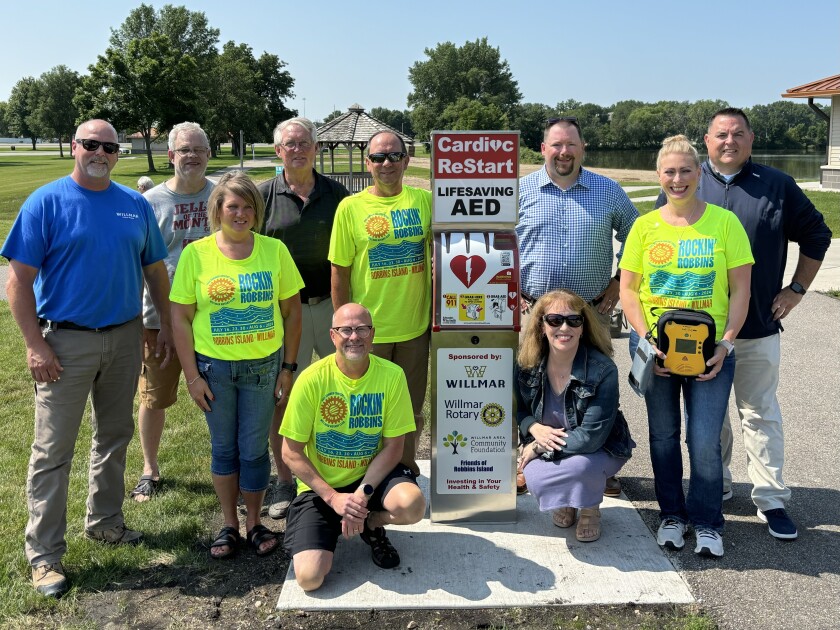WILLMAR ŌĆö Rich Feneis has a litany of stories about someoneŌĆÖs life being saved by an automated external defibrillator.
One such story involved his brother, Bob Feneis, and his friend, Marv Erickson, in 2016. Both were volunteering at Hazeltine National Golf Club in Chaska, Minnesota, during the Ryder Cup.
ADVERTISEMENT
As the two were walking down a trail, Erickson stopped talking and fell over, going into sudden cardiac arrest.
ŌĆ£ItŌĆÖs like somebody turns off an electric switch,ŌĆØ said Rich Feneis.
Thankfully, paramedics were there just in time with an AED.
ŌĆ£It ended up saving his life,ŌĆØ said Feneis. ŌĆ£Now heŌĆÖs back golfing, and he got to see his daughter have their grandchild. I mean, what a change.ŌĆØ
ThereŌĆÖs a reason why Rich Feneis has stories like this. TheyŌĆÖre common ever since he and his longtime friend Joel Vogel started Advocates for Health, a nonprofit organization whose mission is to make AEDs accessible in as many communities as possible.
Vogel started volunteering for heart health organizations after he suffered a heart attack in 2004. He started a golf tournament in 2010 to raise money for AEDs, which inspired Feneis to approach Vogel to start the nonprofit.
What is an AED?
An automated external defibrillator shocks a heart back to normal rhythm for those experiencing cardiac arrest.
ADVERTISEMENT
TheyŌĆÖre important, lifesaving and very expensive.
Most paramedics have AEDs on hand, but in some communities, waiting for paramedics isnŌĆÖt a viable option.
ŌĆ£Where I live in Pine Point (Minnesota), EMS response time is 30 minutes,ŌĆØ Feneis said. ŌĆ£If somebody goes into sudden cardiac arrest, youŌĆÖve got to do something within the first 10 minutes or they just wonŌĆÖt survive.ŌĆØ
Sudden cardiac arrests can be much more lethal than something like a heart attack, according to Feneis.
"A heart attack is a plumbing problem, a sudden cardiac arrest is an electrical problem," he said. "The survival rate from a heart attack is 90%. Sudden cardiac arrest, if you don't have an AED, your chance of survival is less than 5%. And yet, if you have an AED, it's 75% to 85%. That's why they're so important."
Feneis added that sudden cardiac arrests aren't just for old people.
ŌĆ£(About) 370,000 people a year die of sudden cardiac arrest just in the United States, and 23,000 of them are kids 18 and under,ŌĆØ he said. "We've seen every age group. Sudden cardiac arrests doesn't discriminate."
ADVERTISEMENT
ThatŌĆÖs why having AEDs in public places is so important in the eyes of Vogel and Feneis.
Storing outdoor AEDs
Vogel and Feneis both started their work in 2018 with the Pilot Program, which supplied AED cabinets in local parks around Stearns County. After the program, the two officially founded the organization in 2019.
An AED canŌĆÖt be stored in areas where temperatures get below freezing, According to for an AED to be available outdoors, it costs $6,605 for the outdoor cabinet, $895 for the AED itself and $600 a year for annual maintenance costs plus electricity.
For such an important life-saving device, the cost can be covered by donations from the public, local businesses, service clubs and more.
Their work doesnŌĆÖt stop there. Four years ago, Stearns County became the first county in the state to map AEDs for 911 callers with help from Advocates for Health. This provides 911 operators rapid information they can relay to the callers about the closest AED to them.
ŌĆ£ItŌĆÖs been a phenomenal success,ŌĆØ said Bob Knutson of Advocates for Health.
Since then, the project has expanded into Kandiyohi and Meeker counties, with more on the way.
ADVERTISEMENT
Yet Feneis emphasized that the education to use an AED ŌĆ£is just as important as getting the product out there.ŌĆØ
Spreading the word
Knutson, from Spicer, knows people who buy an AED but arenŌĆÖt curious enough to know how to use it. It can be frustrating, he says.
ŌĆ£I know people that donŌĆÖt want to come to the (AED) meeting. They donŌĆÖt care,ŌĆØ he said. ŌĆ£ŌĆśOh, we bought the machine, thatŌĆÖs good enough.ŌĆÖ No, itŌĆÖs not. You gotta know how to use it.ŌĆØ
AED training is done across Minnesota high schools. Students are required to have CPR and AED education before graduating, one of 41 states to do so.
Advocates for Health also holds classes for those who need AED education across the state.
Social media has been great for getting the word out, according to Feneis, but spokespeople have been an enormous help to the organization.
Caitlin Gilk won a gold award for the Girl Scouts thanks to her efforts helping Advocates for Health, raising $22,000 for the devices in the Paynesville area.
ADVERTISEMENT
"She installed over 160 AEDs in Stearns County alone," Knutson said. "She's just incredible."
2024 Miss Minnesota Emily Schumacher has also been helpful to the organization as well, raising money for the organization and is set to make an appearance at this yearŌĆÖs golf tournament.
ŌĆ£She wants to be an open heart surgeon,ŌĆØ Feneis said. ŌĆ£She teaches CPR and AED classes in Rochester, so this is very important to her.ŌĆØ
Saving lives
On July 11, Bob Knutson oversaw another outdoor AED installed, this time at Robbins Island Park in Willmar, a week before the start of the Rockin' Robbins concert series.

Members of the Rotary Club of Willmar, Willmar city staff, Advocates for Health volunteers and other members of the community helped or witnessed the installation.
"It's very important to me because it saved my life," said Tim Rehn of Willmar.
Rehn was playing in an adult hockey league in December 2023 when he at the Willmar Civic Center. Quick-thinking retired emergency medical technician Heather Coleman grabbed an AED at the rink and used it on him, which ended up saving his life.
ADVERTISEMENT
Stories like that are inspiring, but in Rehn's case, Coleman knew what the AED was and how to use it.
For Knutson, Feneis and the rest of Advocates for Health, educating the public is just as important as getting AEDs out there.
ŌĆ£WeŌĆÖre just trying to make people aware,ŌĆØ said Knutson. ŌĆ£From 10 years old to 100 years old.ŌĆØ

















